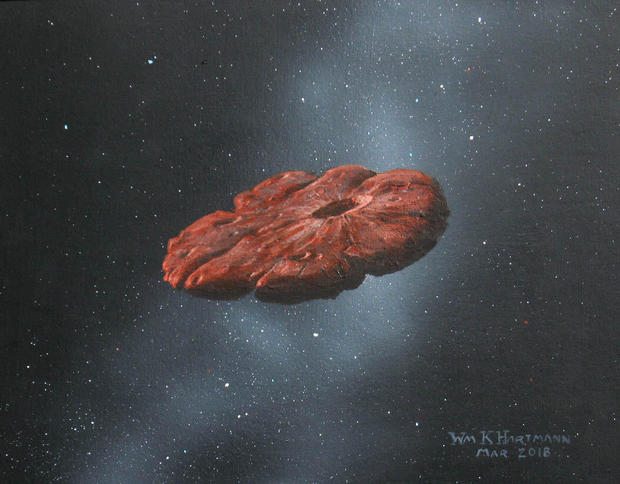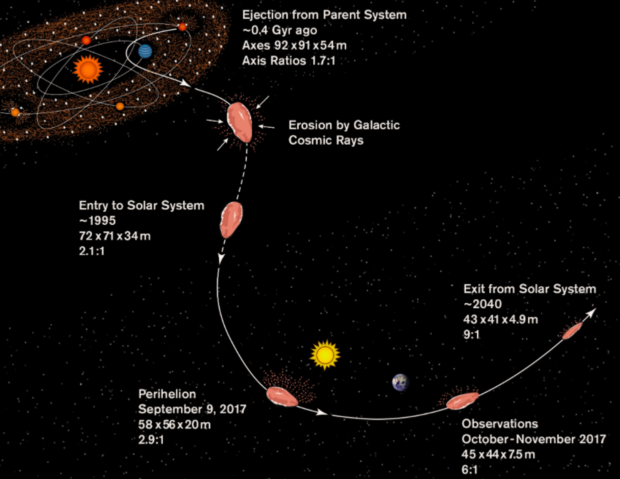▶ Watch Video: Harvard scientists say Oumuamua may be probe sent by “alien civilization”
Sorry, but it’s probably not aliens.
Our solar system’s first known interstellar visitor isn’t a comet or an asteroid either. Rather, scientists now think the mysterious object is likely a remnant of a Pluto-like exoplanet.
It also happens to be shaped like a pancake.
Astronomers at Arizona State University published two new studies this week in the “Journal of Geophysical Research: Planets” that indicate the bizarre, 148-foot object appears to be made up of frozen nitrogen, similar to the surface of Pluto and Triton, Neptune’s largest moon.
The mysterious visitor was named ‘Oumuamua, which means “messenger” or “scout” in Hawaiian, for the observatory in Hawaii that discovered it in 2017. At first, researchers debated heavily if ‘Oumuamua was an asteroid or a comet — and some believed it could be an alien artifact.
“In many ways ‘Oumuamua resembled a comet, but it was peculiar enough in several ways that mystery surrounded its nature, and speculation ran rampant about what it was,” lead author Steven Desch said in a statement.
The object entered our solar system slower than would be expected, at around 196,000 mph, indicating it had not been traveling for more than a billion years. Its peculiar shape, 10 times as long as it is wide, was flatter than any other known object in the solar system.
Researchers now believe some sort of impact broke a chunk of frozen nitrogen off of an icy planet some 500 million years ago. Ever since, the chunk has been zooming out of its own star systems and toward our own. It appears to have a reddish coloration, but scientists believed its outer layers have been worn down, evaporated by cosmic radiation and the sun.
At its closest approach four years ago, ‘Oumuamua was still just a speckle of light millions of miles away from Earth. At the time, scientists found it had to come from beyond our solar system, because its speed and path meant it couldn’t be orbiting the sun.
Using its shine, size and shape, researchers developed computer models that led them to conclude ‘Oumuamua is most likely a gradually eroding chunk of icy nitrogen.
“That was an exciting moment for us,” Desch said. “We realized that a chunk of ice would be much more reflective than people were assuming, which meant it could be smaller. The same rocket effect would then give ‘Oumuamua a bigger push, bigger than comets usually experience.”
“It was likely knocked off the surface by an impact about half a billion years ago and thrown out of its parent system,” co-author Alan Jackson said. “Being made of frozen nitrogen also explains the unusual shape of ‘Oumuamua. As the outer layers of nitrogen ice evaporated, the shape of the body would have become progressively more flattened, just like a bar of soap does as the outer layers get rubbed off through use.”
Not everyone is on board with the idea.
Harvard researcher Avi Loeb claims in a new book that the object appears to be more artificial than natural, probably debris from advanced alien technology – space junk from many light years away. It may have been a type of “light sail” propelled by sunlight, a technology that humans are currently developing for space exploration.
“It’s possible that there is a lot of space junk out there or it is a probe,” he told CBSN. “We don’t know because we didn’t collect enough data, enough evidence and I’m just alerting everyone to look for objects like that so that next time there is one coming by we will examine it more carefully.”
But Desch said the idea that the object is artificial is far-fetched.
“Everybody is interested in aliens, and it was inevitable that this first object outside the solar system would make people think of aliens,” Desch said. “But it’s important in science not to jump to conclusions. It took two or three years to figure out a natural explanation—a chunk of nitrogen ice—that matches everything we know about ‘Oumuamua. That’s not that long in science, and far too soon to say we had exhausted all natural explanations.”
Objects like ‘Oumuamua allow scientists to expand our understanding of other planetary systems.
“This research is exciting in that we’ve probably resolved the mystery of what ‘Oumuamua is and we can reasonably identify it as a chunk of an ‘exo-Pluto,’ a Pluto-like planet in another solar system,” Desch said. “Until now, we’ve had no way to know if other solar systems have Pluto-like planets, but now we have seen a chunk of one pass by Earth.”
Comet 21/Borisov, discovered in 2019, is the only other known object to have arrived in our solar system from another one. More advanced telescopes, like the upcoming Vera Rubin Observatory/Large Synoptic Survey Telescope in Chile, will hopefully help astronomers locate other interstellar objects, now that ‘Oumuamua is long gone.
“It’s hoped that in a decade or so we can acquire statistics on what sorts of objects pass through the solar system, and if nitrogen ice chunks are rare or as common as we’ve calculated,” Jackson said. “Either way, we should be able to learn a lot about other solar systems, and whether they underwent the same sorts of collisional histories that ours did.”




































